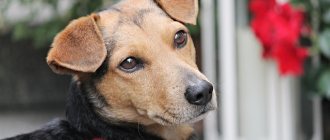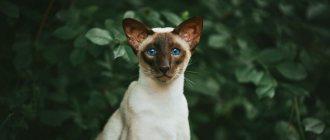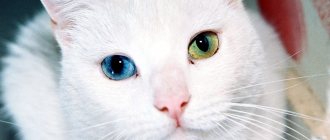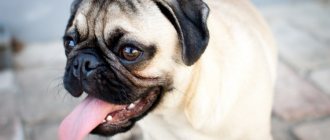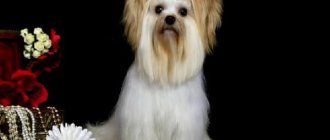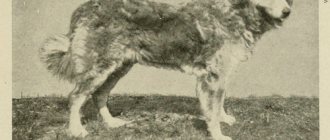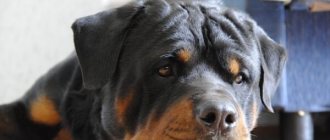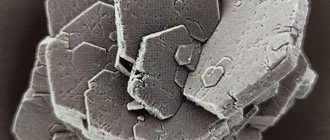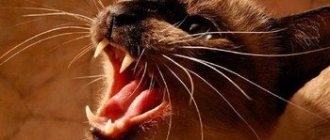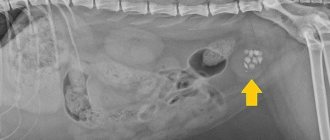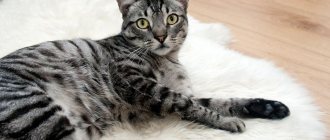There is a lot of controversy regarding the origin of blue tongue dog breeds. These theories range from pagan legends to scientific hypotheses, but in the end the cause is more complex.
Although dark tongues in dogs are usually described as blue in color, they can sometimes have a dark purple or even black tint, but this is caused by additional dark pigment on the skin. If your dog simply has blue spots on his tongue, it may be similar to a human birthmark.
Chow chow
- Origin: China
- Height: from 45.5 to 56 cm
- Weight: from 16 to 40.5 kg
- Activity level: high
- Need for care: high
- Shedding: low
- Hypoallergenic: no
- Tendency to bark: low
- Price range: around $900
- Possible health problems: eyelid entropy, hip dysplasia, elbow dysplasia, allergies and thyroid disorders
The Chow Chow is one of the oldest dog breeds in the world. They are first mentioned in Chinese artifacts as early as 206 BC, although there is evidence that the breed originated much earlier.
Their distinguishing features are a lion's mane around the head and shoulders, a blue-black tongue, deep-set almond-shaped eyes and a bear-like appearance. However, the true reason for the unique coloring of their tongue remains unknown.
Dogs are pets
For a person who, due to character or life circumstances, is forced to lead a lonely lifestyle, a dog can not only brighten up life, but also become the most devoted friend and companion.
Indoor decorative dogs have lived next to people for a long time, being for high-ranking people the personification of wealth and an indicator of social status: the Chinese Crested Dog, the Russian Colored Lapdog, the Pomeranian Spitz, the English Toy Terrier, the Pekingese - all these cute dogs eventually become... the owner is the center of the Universe.
Among the dogs, we can distinguish the so-called universal breeds, for example, schnauzers, bred in Germany, or retrievers, hunters by nature, but surprisingly delicate and intelligent dogs, ideal for home and family. The wonderful, shaggy Komondor (Hungarian Shepherd) is a shepherd by vocation, but feels great in a city apartment and is very strongly attached to his owner.
Keeping some dog breeds requires great responsibility from owners. For example, the English bulldog: this true gentleman lost his fighting qualities over time and turned into a very vulnerable breed in many respects. And vice versa, the Alabai (Central Asian Shepherd Dog), hardened by the initially difficult conditions of existence, is ready to die for the owner and it is unknown how far a dog can go if it senses a potential threat.
Therefore, choosing a dog is a serious and deliberate step, based not on a momentary desire to acquire a touching fluffy ball, but a responsible decision on which the life and future fate of a four-legged friend will depend.
Shar Pei
- Origin: China
- Height: from 46 to 51 cm
- Weight: from 18.5 to 25 kg
- Activity level: moderate
- Maintenance Need: Low to Medium
- Shedding: low
- Hypoallergenic: no
- Tendency to bark: high
- Price range: from 1000 to 1500 dollars
- Possible health problems: Patella luxation, hip and elbow dysplasia, autoimmune thyroiditis, vision problems such as entropy, retinal dysplasia, glaucoma and cataracts, and skinfold infections
The Shar Pei is native to the southern provinces of China and dates back over 2,000 years. Chinese farmers used these rugged, intelligent dogs as hunters, herders, and livestock protectors from predators and livestock rustlers. Some experts believe that Shar Peis may have evolved from Tibetan wolves.
The Chinese Shar Pei is compact, medium in size and a mixture of unusual physical characteristics. It has a broad, hippopotamus-like snout, a blue-black tongue, small sunken eyes, and abundant folds of loose skin around the head, neck, and shoulders.
Convulsions
Convulsions occur as a result of involuntary contraction of the animal's muscles. They are divided into:
- convulsions (short muscle contractions);
- tonic (slow and prolonged muscle contractions);
- clonic (frequently repeated muscle contractions and relaxations);
- generalized clonic-tonic convulsions (mixed);
- epileptic seizure (attack with loss of consciousness.
Seizures in dogs most often occur with hypocalcemia, hypoxia, helminthiasis, and with loss of consciousness due to epilepsy; in addition, the causes of seizures may be the following:
- infectious diseases (rabies, canine distemper, tetanus);
- invasive diseases (toxoplasmosis, helminthiasis);
- hypoparathyroidism;
- brain hypoxia;
- hyperthermia;
- cerebral edema, cerebral hemorrhages, brain tumors;
- hydrocephalus, encephalitis;
- poisoning;
- uremia.
German Shepherd
- Origin: Germany
- Height: from 56 to 66 cm
- Weight: from 22.5 to 40 kg
- Activity level: high
- Need for care: high
- Shedding: high
- Hypoallergenic: no
- Tendency to bark: high
- Price range: from 1500 to 3000 dollars
- Possible health problems: bloating, hip dysplasia, arthritis, degenerative myelopathy, exocrine pancreatic insufficiency
The German Shepherd comes from the German Cattle Dog family and is today the dog of choice for police and military units around the world. Their famous qualities are intelligence, agility, speed, vigilance and steadfastness.
Although some German Shepherds have black or blue spots on their tongues, this is not a very common occurrence. The reason for this coloration of the tongue is identical to the same as in the Chow Chow and Shar Pei breeds, that is, the concentration of pigment cells on the tongue. However, in the German Shepherd, the coloring appears only in some individual dogs.
Variety of colors
The titular purple-tongued dog is a breed that comes in five coat colors:
- Red. It is possible to dye the wool in dark wood tones; golden and yellow tones are allowed. Light spots on the coat are located on the tail, paws and neck. Puppies have a dark muzzle, which changes with age and acquires an even color.
- Black. As a rule, representatives of this color have an even color. There may be a silver tint on the tail. If kept outdoors for a long time, the color of the coat may become rusty.
- Cream. The most common representatives of the breed are beige, close to white. The peculiarity of this color is that with age the wool can change its color to yellow-brown. Over time, the nose becomes not blue, but brown.
- Blue. The Chow Chow dog of this color has a deep blue color, with silver tints possible. The nose can be either gray or black. The only requirement for this purple-tongued dog is that it must not have a brown nose.
- Tsimt. This color is characterized by white and beige tones, possibly pinkish and gray. A special feature of this coat color is the presence of a grayish muzzle.
Akita
- Origin: Japan
- Height: from 56 to 61 cm
- Weight: from 23.5 to 39 kg
- Activity level: high
- Need for care: high
- Shedding: high
- Hypoallergenic: no
- Tendency to bark: high
- Price range: from 600 to 2000 dollars
- Possible health problems: hip and elbow dysplasia, progressive retinal atrophy and autoimmune hypothyroidism
Akita is a dog that originated from ancient Japan and was respected there for its loyalty and courage. This is a very independent and intelligent breed. At various times throughout its long history, the Akita has teetered on the brink of extinction.
This fox-like dog has thick fur that comes in several colors, a wide and massive head, and a fluffy and curled tail. Although the Akita's tongue is usually pink, it may have blue or black spots.
The importance of hardening
Sometimes the owners “shake” over their children, protecting them from the slightest breath of wind, so that, God forbid, they don’t get sick. Here lies a fatal mistake: a dog raised in greenhouse conditions cannot resist the effects of a cold due to weak immunity
Therefore, it is so important to accustom the animal to the surrounding unfavorable factors.
The easiest way to increase resistance is to start hardening, this improves the heat regulatory system.
Of course, it needs to be hardened gradually and within reasonable limits: you shouldn’t throw it out into the cold and wait for it to get used to the cold and stop perceiving it.
Only repeated, constant, and most importantly increasing exposure to cold will lead to the expected result. And most importantly, hardening is carried out against the background of abundant and nutritious nutrition.
Rottweiler
- Origin: Germany
- Height: from 56 to 69 cm
- Weight: from 35 to 59 kg
- Activity level: high
- Maintenance Needs: Moderate
- Shedding: moderate
- Hypoallergenic: no
- Tendency to bark: low
- Price range: $1500 to $2500
- Possible health problems: Progressive retinal atrophy (PRA), cataracts, eyelid deformation and other vision and eye problems, heart problems
The Rottweiler is an ancient breed that spread throughout the European continent along with the armies of the Roman conquerors. Rottweilers were among the first guide dogs for the blind, and in recent years they have proven to be excellent search and rescue dogs.
The shiny short black coat with characteristic rust markings adds impressive power to the Rottweiler's appearance. Some Rottweilers may have blue tongues, which look more like dark spots or age spots.
Care and maintenance
You can keep a chow chow both in an apartment and in a private house by equipping your pet with a spacious enclosure. The more time a dog spends outside, the more magnificent and beautiful its fur becomes.
Professional care
The dog's fur does not mat and has self-cleaning properties. You need to comb it once a week using a metal wide-toothed comb. During periods of shedding (2 times a year), the pet is brushed 3-4 times a week.
After each walk, they limit themselves to washing their paws. They bathe the animal 2-3 times a year, using a special shampoo and conditioner. After the procedure, the dog must shake itself off, then it is combed and its coat is dried with a hairdryer. The Chow requires periodic grooming to maintain its beautiful appearance.
It is necessary to monitor the condition of the eyes, ears, teeth, mouth, claws and regularly perform hygiene procedures.
You need to walk the animal 2 times a day, for at least 2 hours.
Nutrition
A two-month-old puppy is fed 5-6 times a day, gradually reducing the number of meals, bringing them to 2 times, sufficient for an adult.
Feeding can be of two types: natural or prepared food. Regardless of the type chosen, the pet’s diet must be balanced.
A dog whose owner prepares his own food requires:
- fresh lean meat;
- boiled sea fish, boned;
- fermented milk products (kefir, cottage cheese, fermented baked milk);
- porridge (buckwheat, rice);
- boiled or steamed vegetables (cabbage, lettuce, greens);
- vitamins and minerals.
— I want to eat!..
Ready-made food attracts people with its balanced composition of nutrients, vitamins and minerals, and significantly saves the owner’s time. Chows are suitable for food of at least the super premium class - harmless, high quality, but expensive.
Tibetan mastiff
- Origin: Tibet
- Height: from 61 to 76 cm
- Weight: from 34 to 72.5 kg
- Activity level: low
- Maintenance requirement: low
- Shedding: low to moderate
- Hypoallergenic: no
- Tendency to bark: low
- Price range: from 1500 to 5000 dollars
- Possible health problems: autoimmune thyroiditis, hip and elbow dysplasia, seizures and hereditary demyelinating neuropathy
This breed is very ancient, although it is impossible to say how and when Tibetan Mastiffs appeared, since Tibet has always been isolated from the rest of the world. Historical documents indicate that early travelers to Tibet were sometimes given these giant dogs as gifts, which were later used to create other mastiff breeds in the Middle East and Europe.
Tibetan Mastiffs can reach 66 cm at the shoulders and weigh over 50 kg. Words such as powerful, massive and muscular are often used to describe this breed. However, Tibetan Mastiffs are nimble and recognize threats with amazing agility. Most of these dogs have pink tongues, but some have tongues with black or blue-black spots.
Why is the tongue blue
Some try to explain the unusual color of the language from a scientific point of view, others trust beautiful legends and tales.
Legends
There are some versions and legends that explain this unique phenomenon. One of the Chinese legends says that during the creation of the world, the gods, after creating the Earth and populating it with numerous living creatures, began to “decorate” the sky. When they were distributing the stars across the sky, a piece of it accidentally broke off and fell to the ground. The animals and birds got scared and tried to find shelter, but the chow-chow came up to the piece, sniffed it and carefully licked it. Since then, the brave dog's tongue has acquired a heavenly hue. Thanks to this legend, representatives of the breed are also called “the dog that licked the sky.”
According to Korean legend, the chow chow was a small Korean bear that ate a lot of blackberries, then it mutated into a modern dog, but the color of its tongue remained blue. Additional confirmation of this is the appearance of the dogs, which look like small fluffy bear cubs, as well as their original gait and independent nature.
Scientific explanations
Scientists have been studying this breed for a long time, but have not found a clear explanation for the unique color. They naturally do not trust legends and believe that chow chows appeared more than 3,000 years ago in China. This is confirmed by a figurine belonging to the Han Dynasty (206-220 BC) depicting representatives of this breed.
Mongolia is also considered as a possible homeland for these dogs, where they came from Siberia, and even before that from the Arctic. The animals lived in harsh conditions with low oxygen levels. Today, a blue tongue is considered a symptom of an acute lack of oxygen, so this version looks quite plausible.
One version suggests that chow chows descended from polar wolves, which became extinct several centuries ago. It is to them that they owe the inheritance in the form of the color of the tongue.
Pomeranian Spitz
- Origin: Pomerania (region in northwestern Poland and northeastern Germany)
- Height: from 18 to 30.5 cm
- Weight: from 1.5 to 3.2 kg
- Activity level: moderate
- Maintenance Needs: Moderate
- Shedding: low to moderate
- Hypoallergenic: no
- Tendency to bark: moderate
- Price range: $500 to $6,000
- Possible health problems: Patellar luxation and tracheal collapse
The Pomeranian is a miniature version of the powerful Arctic sled dogs of the Spitz type. This breed is named after Pomerania, a region in northeastern Europe that is now part of Poland and West Germany. The Pomeranian is one of the most popular toy dog breeds in the world.
These dogs have a thick double coat with frills extending across the chest and shoulders. They come in nearly two dozen colors with a variety of patterns and markings. However, the most common Pomeranians are light brown and red in color. Some Pomeranians have a blue tongue or have blue spots on it, although most of this German dog breed have a pink tongue.
Causes of blue mucous membranes in other breeds
Blueness of the mucous membrane in a dog is also called cyanosis. A disease such as cyanosis cannot be called independent, but its external manifestation is considered a sign of quite serious problems with the body.
A dog's tongue may acquire blue pigmentation, and this always indicates a lack of oxygen in the body. The main reasons for the development of blue tongue are:
- Lung diseases that cause a rough cough, swelling in the lungs and severe shortness of breath.
- Injuries to the lungs, which can develop pneumothorax and hydrothorax (large amounts of air or fluid in the chest cavity).
- Hypertrophy in the velum palatine.
- The process of narrowing of the trachea (collapse).
- Congenital heart defects.
The listed diseases and injuries can occur in an animal of any breed, but, for example, hypertrophy often occurs in brachycephalic breeds (Pekingese, pugs, boxers and others), and tracheal collapse in most cases occurs in small and dwarf breeds (Yorkies, Shih Tzu and toy terriers).
Korean Jindo
- Origin: South Korea
- Height: from 46 to 56 cm
- Weight: from 15 to 23 kg
- Activity Level: Moderate to High
- Need for care: high
- Shedding: moderate
- Tendency to bark: low
- Price range: from 800 to 1000 dollars
- Possible health problems: allergies and hypothyroidism
The Chindo breed comes from the island of the same name, located off the southwestern coast of South Korea. The dogs lived freely on the island with their owners for thousands of years, naturally developing their hunting skills.
The Korean Chindo is a well-built, medium-sized dog that is used for hunting and guarding. With erect ears and alert eyes, the Korean Jindo represents agility, strength, vigilance and dignity. It has a soft and dense coat that can be tan, white, black or grey. Some Korean Jindo have a blue or blue-black tongue.
How much does it cost and how to choose a puppy?
When planning to buy a shaggy pet, you need to understand the purpose for which it is being done. The price of a Chow Chow puppy is determined by the breed qualities:
Babes
- from hand, not for subsequent breeding – up to $150;
- PET class – $200-250;
- BRID class – $500-800;
- SHOW class – from $1200.
It is best to purchase a 2-month-old puppy from a nursery. The buyer has the opportunity to familiarize himself with the conditions of its maintenance and make sure that the breed is purebred. A healthy, promising puppy should be active, with shiny and clean eyes, fur, ears and skin.
Border Collie
- Origin: England, Scotland
- Height: from 46 to 56 cm
- Weight: from 12.5 to 20.5 kg
- Activity level: high
- Maintenance requirement: low
- Shedding: moderate
- Hypoallergenic: no
- Tendency to bark: high
- Price range: from $600
- Possible health problems: epilepsy, hip dysplasia, hypothyroidism
These dogs dominate championships in the fast-growing sport of agility, and they often top lists of the world's smartest dog breeds. The intense gaze of the Border Collie's almond-shaped eyes further gives them an intelligent appearance.
Their smooth coats come in a variety of colors and patterns. The famous herding nature of the Border Collie is a distinctive feature of this breed. Like some of the breeds discussed earlier, some Border Collies have naturally blue tongues, either with blue-violet pigmentation or blue-black markings.
Treatment
To identify the causes of the disease and assess the severity of the process, differential diagnostics is carried out in our veterinary clinic.
In our work we use the following methods: obtaining clinical, biochemical, hematological studies of blood and urine; Ultrasound of the kidneys and abdominal organs. Based on the results obtained and analysis of information, the veterinarian makes a diagnosis and develops an individual treatment regimen. Manifestations of kidney diseases usually become noticeable only when 60-70% of the kidney nephrons are damaged. Moreover, such pathologies most often become chronic. Their treatment becomes quite a difficult task, since the course is long and requires the inclusion of herbal medicines. Acute kidney disease is often accompanied by a poor prognosis.
In the fight against kidney disease, measures are taken to eliminate intoxication and its causes. This includes adjusting the dog’s diet if it needs it. Symptomatic treatment is used. In case of renal failure, the main efforts are aimed at eliminating the causes, correcting the imbalance of fluid and electrolytes in the body, stimulating the formation and outflow of urine, as well as removing toxins from the body.
What medications can the doctor prescribe?
- A long course of oral medications is administered to stimulate blood flow to the kidneys and lower blood pressure.
- Kidney diseases can manifest themselves in multiple and seemingly unrelated symptoms, therefore, as mentioned earlier, one of the components of the treatment of kidney diseases are drugs that help cope with individual clinical manifestations that contribute to the development of pathology.
- Injections of long-acting medications are prescribed to increase and maintain the dog's appetite and slow down weight loss.
Differential diagnosis
Differentiate leptospirosis from canine distemper. Distemper is more often diagnosed in young dogs, and leptospirosis in adults.
Leptospirosis can be distinguished from plague by the presence of bloody vomiting, an increased amount of protein in the urine, and the presence of bile pigments in it. Often, at an early stage of the disease, it is possible to differentiate plague from leptospirosis only with the help of laboratory tests.
It is also necessary to exclude piroplasmosis, a dangerous disease in dogs - the blood is examined for the presence of blood parasites, food poisoning, immune hemolytic anemia, viral hepatitis, herpes virus infections, brucellosis, canine distemper, toxoplasmosis, liver and kidney neoplasms, urolithiasis.
Character traits
Due to their appearance, Chow Chows look menacing and gloomy. But in reality they are not aggressive and cheerful. They become attached to the owner and are friendly with other family members, but do not like familiarity. They get along well with children, but will not tolerate it if a child hurts them.
These dogs always behave in a reserved manner; they are introverts by nature. They never show violent feelings. Joy is expressed by a slight twitch of the tail, sometimes whining. They do not understand excessive emotionality in humans, but they are able to sense the mood of the owner. In a dangerous situation, the dog will not hesitate to rush to defense, even if he has not been trained to do so.
They treat strangers with caution, but without aggression. They get along well with pets if they grow up with them. They just don't tolerate other dogs in the house. They may chase other people's cats on the street.
Representatives of this breed have the following character traits:
- pride;
- stubbornness;
- independence;
- self-sufficiency;
- touchiness;
- loyalty;
- equilibrium;
- restraint.
Education and training
The Chow Chow is a very intelligent dog with a good memory, but its independent nature and innate stubbornness make it difficult to train. She is prone to dominance and will only listen to someone who has been able to gain authority from her. The dog carries out commands reluctantly, sometimes after much thought. If he doesn’t understand why he should sit in one position or jump for a long time, he won’t do it.
It will take a lot of patience to train a Chow Chow. It is especially difficult to raise a male dog, as they are very prone to dominance. When training, it is advisable to follow the recommendations of dog handlers:
- you cannot indulge your pet’s whims, prohibitions must be consistent, all family members must adhere to the same requirements;
- this dog must be treated with respect, the main method of training should be treats, affection and praise;
- rudeness is unacceptable, these dogs react poorly to violence, are touchy and may lose interest in activities;
- Early socialization is important; the puppy needs to be accustomed to street noise, strangers, and cars.
You yourself need to learn the basic commands with your dog: “sit”, “lie down”, “place”, “come to me”, “no”, “near”. More serious training is recommended under the guidance of an experienced dog handler.
Symptoms of postcholecystectomy syndrome
At its core, PCES is a consequence of surgery for resection (removal) of the gallbladder. This means that after resection the patient may experience unpleasant symptoms, such as:
- dyspepsia or disruption of the normal functioning of the stomach, manifested in the form of bitterness in the mouth, nausea, bloating and intestinal upset;
- pain in the right hypochondrium with transition to the right collarbone or shoulder. The intensity of pain can vary, from unexpressed aching to acute burning;
- general weakness, pale skin (appears against the background of poor absorption of food and developing vitamin deficiency).
With PCES, other symptoms are possible due to exacerbated diseases:
- exacerbation of cholangitis - inflammation of the bile ducts - is expressed in a long-lasting temperature in the range of 37.1-38.0 ° C;
- Cholestasis (stagnation of bile in the liver tissue) can cause severe jaundice2.
Raising a pet
Due to the stubborn nature of the Chow Chow, you need to be prepared for the fact that at some periods of its life the dog will refuse to obey and test the owner’s patience. The owner must not fall for the pet's tricks. With a Chow Chow you need to be moderately strict and demanding. Excessive gentleness towards the dog or, on the contrary, rudeness will lead to the fact that the pet will completely stop obeying and will not see the leader in the person. You can stimulate the Chow Chow's interest in a particular activity through a game or a piece of his favorite treat.
Raising a dog should begin from the first days the puppy appears in the house. Already from 2-3 months, the baby should understand where his sleeping place is. It is prohibited to place the dog next to you on the bed, since in this case the pet will feel equal to the owner.
You can only feed your dog from bowls. Never give food from the table, otherwise the chow chow will grow up to be a beggar.
The baby must have rubber toys for teething. If you don’t buy them, your pet will begin to damage the furniture.

